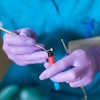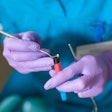For our final clinical tip of 2024 to help your dental practice, we are thrilled that Dr. Mike Skramstad is back to share his knowledge, courtesy of CDOCS.
For more great tips and ideas on how to level up your clinical knowledge, visit CDOCS. Also, you can learn more about CDOCS' hands-on workshops.
Video transcript
"Before sandblasting the titanium base, you need to block out the emergence profile using a wax or in this case I used a liquid dam. Once you have blocked it out, in this case with a liquid dam, I go ahead and light-cure. When this is complete, I can now begin sandblasting the titanium base. This is a Danville Microetcher, sandblasting the titanium base thoroughly to make sure you remove all the shine and dull it out. This will create a better bond with the multilink hybrid abutment.
"After the titanium base has been sandblasted, the next step is to apply Monobond Plus to the titanium base. Monobond Plus has metal primers, which will aid in the bonding of the e.max abutment to the titanium base using multilink hybrid abutment. After the Monobond Plus is applied, allow 60 seconds to react and then with a light air stream, dry off all the Monobond Plus from the titanium base.
"Now we're going to move to the e.max Hybrid abutment crown and apply 5 % hydrofluoric acid for 20 seconds. After the reaction has occurred, go ahead and rinse this thoroughly. After the hydrofluoric acid is rinsed, go ahead and apply the Monobond Plus to the inside or bonding surface of the e.max Hybrid abutment crown.Using a waterproof marker, mark the female connection of the precision attachment on the e.max abutment and the male notch of the titanium base on the implant analog.
"We are now ready to place the multilink hybrid abutment directly on the titanium base. Notice I do not have the screw access hole of the titanium base blocked out. By doing this, when I seat the e.max abutment, all the excess will move out of the bottom of the titanium base and not get stuck in the screw access hole. If I placed multilink hybrid abutment inside the e.max abutment, you would need to block out the screw access hole.
"So at this point, we'll line up the two marks with the waterproof marker we made and press firmly to make sure it's seated. After two to three minutes of autopolymerization, we'll begin to remove the excess multilink hybrid abutment from the complex. After removing the gross excess, a great way to complete initial cleanup is by using a 2x2 gauze and wiping the complex clean.
"After initial cleanup, it's important to apply a glycerin gel to the cementation joint to prevent the formation of an oxygen inhibition layer. In this example, I'm using Liquid Strip from Ivoclar Vivadent. You want to cover the cementation joint completely in preparation for final polymerization. After letting the complex autopolymerize for up to seven minutes, we can go ahead and rinse the glycerin gel completely off the restoration.
"The final step in the process is to use rubber wheels to polish the cementation joint. It's very important to use low rpms to avoid overheating the porcelain. And that completes the process of using a multilink hybrid abutment to bond an e.max abutment to a Sirona titanium base. Notice how well the high opacity blocks out the titanium base from showing through the porcelain. You are now ready to deliver the restoration to the patient."



















